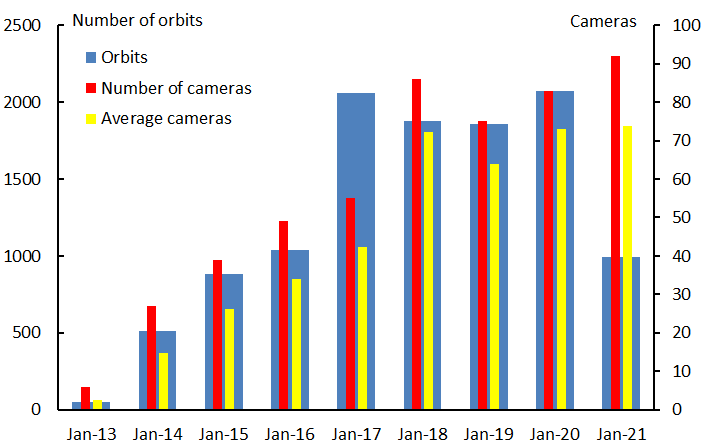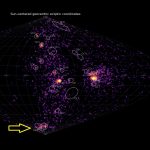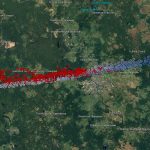Abstract: A summary of the activity of the CAMS BeNeLux network during the month of January 2021 is presented. January 2021 was a typical winter month with mostly unfavorable weather circumstances. 2725 multi-station meteors were recorded, good for 991 orbits. January 2021 was the poorest month of January since 2015 in spite of a record number of cameras available.
1 Introduction
January tends to be one of the worst months for astronomy in the BeNeLux with mostly overcast sky. During the 8 past years the CAMS BeNeLux network did not have any single month of January with favorable weather circumstances. It looks like January is the most difficult month for the weather circumstances, a pity as the nights are very long for the BeNeLux area while the meteor activity is still at a fairly good level. Would 2021 bring us finally better luck for January?
2 January 2021 statistics
The new year 2021 started like 2020 ended, with cloudy sky and little or no chance to do astronomical observations. The best we got were nights with some clear spans. As many as 9 nights ended without any single orbit. Also, the Quadrantid maximum night was completely missed this year.
CAMS BeNeLux captured only 2725 multi-station meteors (6045 in 2020, 5124 in 2019), good for 991 orbits (2075 in 2020, 1857 in 2019), the worst month of January since 2015. Only three nights had more than 100 orbits, the best night 8–9 January had 188 orbits. In 2020 the Quadrantid night 3–4 January alone had as many as 660 orbits.
At best 92 operational cameras were active during some nights in January 2021 (83 in 2020). On average 73.7 cameras were capturing per night. Thanks to AutoCAMS and the meanwhile significant number of RMS cameras, the surveillance of the BeNeLux sky was guaranteed with a minimum of 64 active cameras on all nights, same number as last year. On 22 nights orbits have been collected. The long winter nights may often start with an overcast sky looking hopeless to get anything like clear sky, but nights with up to 14 hours of dark sky often prove to have time spans with unpredicted clear sky. Casual observers often remain unaware of such clear periods while the AutoCAMS and RMS users get happily surprised when confirming unexpected meteors. A substantial part of the January 2021 orbits comes from this permanent alertness provided by AutoCAMS and RMS.

Figure 1 – Comparing January 2021 to previous months of January in the CAMS BeNeLux history. The blue bars represent the number of orbits, the red bars the maximum number of cameras running in a single night and the yellow bars the average number of cameras running per night.
Table 1 – January 2021 compared to previous months of January.
| Year | Nights | Orbits | Stations | Max. Cams | Min. Cams | Avg. Cams |
| 2013 | 7 | 49 | 6 | 6 | – | 2.6 |
| 2014 | 21 | 514 | 11 | 27 | – | 14.8 |
| 2015 | 22 | 880 | 14 | 39 | – | 26.1 |
| 2016 | 25 | 1037 | 15 | 49 | 10 | 34.0 |
| 2017 | 23 | 2058 | 18 | 55 | 18 | 42.3 |
| 2018 | 25 | 1878 | 22 | 86 | 53 | 72.0 |
| 2019 | 22 | 1857 | 20 | 75 | 54 | 64.0 |
| 2020 | 23 | 2075 | 21 | 83 | 64 | 72.9 |
| 2021 | 22 | 991 | 26 | 92 | 64 | 73.7 |
| Tot. | 190 | 11339 |
Figure 1 and Table 1 show the evolution compared to the previous months of January. Remarkable many cameras in the northern part of the BeNeLux network remained inactive during several nights while the southern part remained fully operational. Poor weather is the main cause for the low number of orbits, but of course with many of the cameras kept switched off several nights the chances for multi-station events for the remaining active cameras get much reduced.
3 Conclusion
The team members spent a lot of efforts to get some results out of mostly cloudy nights. Despite several extra RMS cameras compared to last year, the larger camera capacity couldn’t compensate the unfavorable weather circumstances.
Acknowledgment
This report has been based on the CAMS BeNeLux data listed on the CAMS website. Many thanks to all participants in the CAMS BeNeLux network for their dedicated efforts. Thanks to Carl Johannink for coordinating the network data. The CAMS BeNeLux team is operated by the following volunteers:
Hans Betlem (Leiden, Netherlands, CAMS 3071, 3702 and 3073), Felix Bettonvil (Utrecht, Netherlands, CAMS 376 and 377), Jean-Marie Biets (Wilderen, Belgium, CAMS 379, 380, 381 and 382), Martin Breukers (Hengelo, Netherlands, CAMS 320, 321, 322, 323, 324, 325, 326 and 327), Guiseppe Canonaco (Genk, RMS 3815), Pierre de Ponthiere (Lesve, Belgium, RMS 3816), Bart Dessoy (Zoersel, Belgium, CAMS 397, 398, 804, 805, 806), Tammo Jan Dijkema (Dwingeloo, Netherlands, RMS 3198, 3199), Jean-Paul Dumoulin, Dominique Guiot and Christian Walin (Grapfontaine, Belgium, CAMS 814 and 815, RMS 003814), Uwe Glässner (Langenfeld, Germany, RMS 3800), Luc Gobin (Mechelen, Belgium, CAMS 3890, 3891, 3892 and 3893), Tioga Gulon (Nancy, France, CAMS 3900 and 3901), Robert Haas (Alphen aan de Rijn, Netherlands, CAMS 3160, 3161, 3162, 3163, 3164, 3165, 3166 and 3167), Robert Haas (Texel, Netherlands, CAMS 810, 811, 812 and 813), Robert Haas / Edwin van Dijk (Burlage, Germany, CAMS 801, 802, 821 and 822), Kees Habraken (Kattendijke, Netherlands, RMS 000378), Klaas Jobse (Oostkapelle, Netherlands, CAMS 3030, 3031, 3032, 3033, 3034, 3035, 3036 and 3037), Carl Johannink (Gronau, Germany, CAMS 311, 314, 317, 318, 3000, 3001, 3002, 3003, 3004 and 3005), Hervé Lamy (Dourbes, Belgium, CAMS 394 and 395), Hervé Lamy (Humain Belgium, CAMS 816), Hervé Lamy (Ukkel, Belgium, CAMS 393), Koen Miskotte (Ermelo, Netherlands, CAMS 351, 352, 353 and 354), Tim Polfliet (Gent, Belgium, CAMS 396), Steve Rau (Zillebeke, Belgium, CAMS 3850 and 3852), Paul and Adriana Roggemans (Mechelen, Belgium, CAMS 383, 384, 388, 389, 399 and 809, RMS 003830 and 003831), Hans Schremmer (Niederkruechten, Germany, CAMS 803) and Erwin van Ballegoij (Heesch, Netherlands, CAMS 347 and 348).






